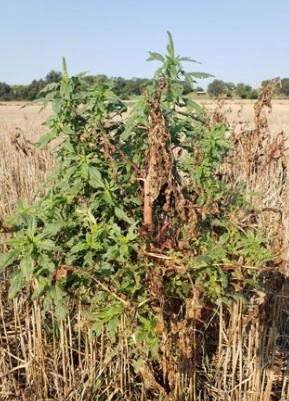By Sarah Lancaster and Jeanne Falk Jones
Post-harvest weed control in wheat stubble is very important to conserve critical soil moisture and prevent weeds from going to seed and adding to the weed seedbank. This year, it will be especially important to be ready to spray after wheat harvest because of less cover from shorter and thinner wheat than we have seen in the last few years in many areas.
When thinking about weed control in wheat stubble, there are two priorities – controlling already emerged weeds and preventing later flushes. Making applications before weeds exceed 4 to 6 inches is necessary for good control of already emerged weeds (Figure 1). Residual herbicides are needed to reduce the number of herbicide applications needed to control multiple flushes of weeds.

Figure 1. This large Palmer amaranth is regrowing after being sprayed with paraquat.
The standard treatment for many years to control weeds and volunteer wheat in wheat stubble was glyphosate plus 2,4-D LVE and/or dicamba. This tank-mix provided two herbicide modes-of-action to help target challenging (and often drought-stressed) weeds. These herbicides continue to be important for weed control in wheat stubble. However, these tank-mixes may not be adequate in many cases because of herbicide resistance in weed populations, particularly glyphosate resistance in Palmer amaranth and kochia. Higher rates of the 2,4-D and dicamba may improve control, but in most cases 1 qt/acre of 2,4-D or 1 pint/acre of dicamba are the highest rates that should be used.
Paraquat (Gramoxone, others) is one herbicide that can work well in place of glyphosate to control emerged pigweed and kochia. Paraquat is a contact herbicide with a different mode of action (Group 27 - cell membrane disruptor), so spray coverage is critical. Spray volumes of 20 gallons/acre or higher are preferred, especially on larger weeds or denser stands. Recent work at K-State suggests that making the paraquat application as soon as possible following wheat harvest allows for better coverage and more effective control, especially on pigweeds. Paraquat also needs to be applied with a non-ionic surfactant or oil concentrate to enhance surface coverage of the plant foliage. A tank mix with atrazine will enhance control on emerged weeds and provide some residual weed control, if planning to plant corn or sorghum next spring. Likewise, metribuzin can be tank-mixed with paraquat if rotating to soybean to enhance control and provide some residual activity.
If planting wheat this fall, saflufenacil (Sharpen) applied at one to two fluid ounces per acre is an option to provide postemergence and short-term residual control of Palmer amaranth, kochia and other broadleaf weeds. Sharpen should be applied with glyphosate for grass control, and can be applied with other products labeled for use in wheat stubble. Sharpen works best with the addition of methylated seed oil and good spray coverage, so using 15 to 20 gallons/acre spray solution is important. If rotating to soybean, note the zero to 45-day rotation interval, depending on use rate and soil texture
Flumioxazin (Valor and others) can be added to burndown treatments at rates of one to four fluid ounces per acre for activity on emerged broadleaf weeds and some residual activity on broadleaf and grass weeds in wheat stubble. Flumioxazin can be mixed with glyphosate or clethodim (Select Max) for enhanced grass control. It can also be mixed with 2,4-D, atrazine, metribuzin, or paraquat. Wheat can be planted 30 days after 2 oz/ac, or 60 days after 3 oz/ac Valor application, if at least one inch of rain occurs between application and planting. Corn, sorghum, cotton, sunflowers, or soybeans can be planted in the spring following flumioxazin treatment. Residual weed control with flumioxazin will depend on rainfall (0.25 inch) for activation, just as with pre-plant treatment in soybeans.
It should be noted that saflufenacil and flumioxazin provide relatively short-lived residual control, when compared to other residual activity herbicides. Observations suggest flumioxazin has longer residual activity than Sharpen. However, either product will provide some residual weed control that may be enough to reduce the number of sprays for the remainder of the summer/fall.
For more detailed information, see the “2022 Chemical Weed Control for Field Crops, Pastures, and Noncropland” guide available online at https://www.bookstore.ksre.ksu.edu/pubs/CHEMWEEDGUIDE.pdf or check with your local K-State Research and Extension office for a paper copy. The use of trade names is for clarity to readers and does not imply endorsement of a particular product, nor does exclusion imply non-approval. Always consult the herbicide label for the most current use requirements.
Source : ksu.edu